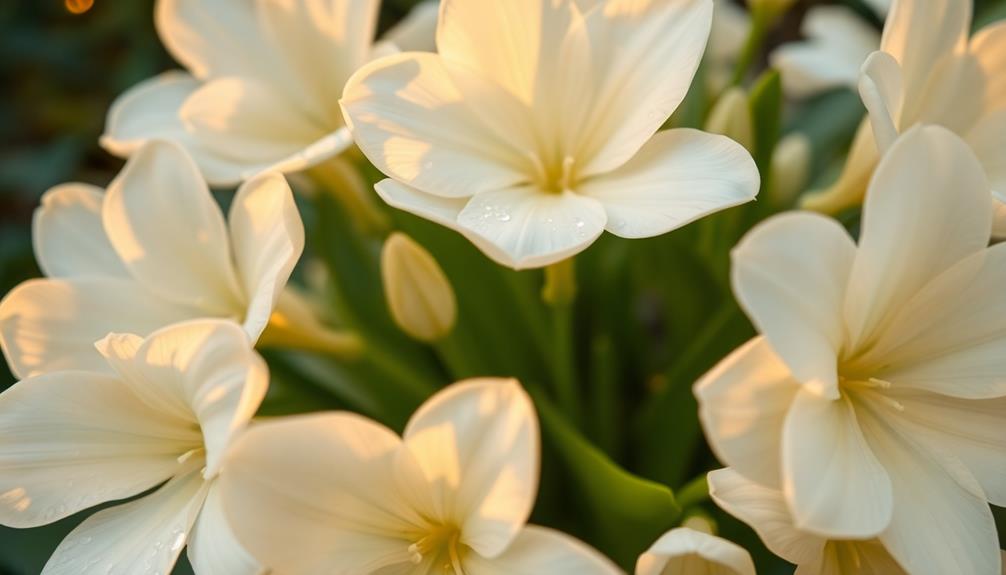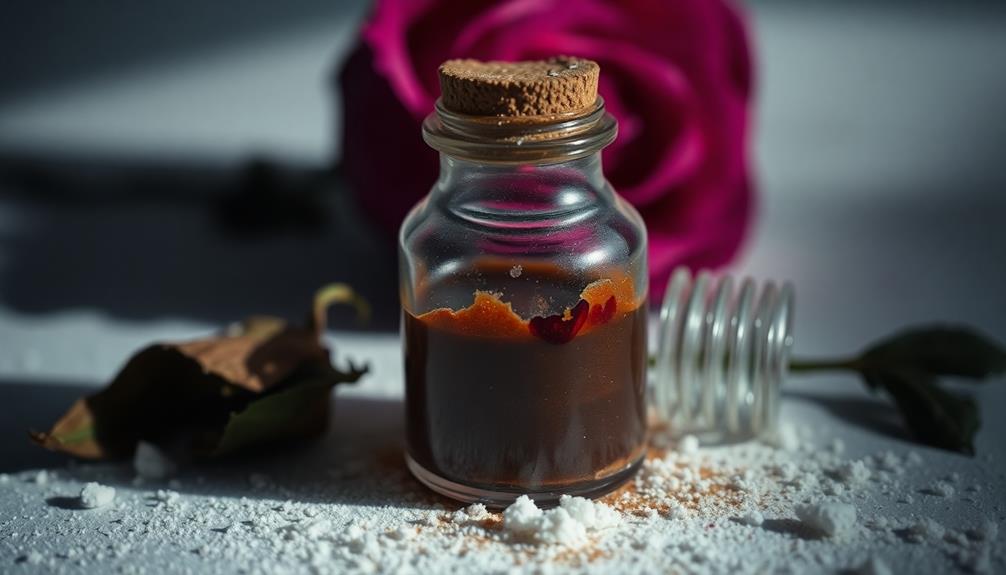Tuberose has a rich, sweet, and intoxicating floral scent that draws you in. It's often described as creamy and honeyed, with hints of jasmine and orange blossom. This captivating fragrance can transform your mood, making it perfect for special occasions like weddings or romantic evenings. Found mainly in warm climates like Mexico and India, tuberose adds depth to perfumes, particularly feminine ones. While its scent is delightful, be cautious—tuberose can be toxic if ingested or irritating for sensitive skin. Discovering its layers of aroma can be a delightful journey, so there's more to explore!
Key Takeaways
- Tuberose has a rich, intoxicating floral aroma characterized by sweet honey and creamy undertones.
- Its scent profile includes exotic notes reminiscent of jasmine and orange blossom.
- The fragrance is complex, often evoking sensuality and seductive imagery.
- Tuberose is commonly used in feminine perfumes, enhancing warmth and depth.
- It is associated with romance and is frequently featured in wedding fragrances and celebrations.
Introduction

Tuberose's enchanting fragrance captivates the senses with its rich, heady floral notes. This flower's scent is truly unique, blending sweet honey and an exotic aroma that draws you in. When you smell tuberose, you might notice its complex fragrance profile, which can remind you of jasmine and orange blossom. These notes give it a creamy texture, making it feel luxurious and inviting.
Often used as a heart note in perfumes, tuberose adds depth and richness to feminine fragrances. Its narcotic odor is both evocative and sensual, making it a favorite among those who appreciate powerful floral scents. Some perfumes even highlight nutty or fruity undertones, depending on the extraction method used.
As you explore tuberose, think of how it can transform any fragrance. Its heady, intoxicating scent can lighten your mood or bring a festive spirit to any occasion.
In the world of perfumery, tuberose stands out, enchanting everyone who encounters its warm embrace. Whether you're looking for a signature scent or a special gift, tuberose is sure to impress!
Description of the Smell

When you encounter the smell of tuberose, you're greeted by a rich and intoxicating floral aroma that captivates the senses. This fragrance is sweet and heady, reminding you of jasmine and orange blossom, but it has its own unique charm.
The scent of tuberose often carries creamy, honeyed undertones that add warmth to its floral character. As you breathe it in, you'll notice the complex layers that come alive, making it a favorite in many perfumes.
Tuberose is usually a heart note in fragrances, meaning it's the core of the scent that shines through after the top notes fade. Its aroma feels seductive and carnal, often bringing to mind images of a femme fatale.
Some variations even give off almondy and fruity hints, enhancing its sensual quality.
Source and Composition

The captivating scent of tuberose comes from its delicate flowers, which are primarily sourced from regions with warm climates, such as Mexico, India, and parts of Southeast Asia.
These fragrant flowers are known for their rich and heady aroma, blending creamy, milky undertones with honeyed elements. When you experience the scent of tuberose, you might also notice green and earthy accents that add to its complexity.
In perfumery, tuberose is often used as a heart note, enhancing warmth and sensuality in fragrances. It blends beautifully with other floral notes, fruity scents, gourmand flavors, and spicy elements.
The extraction of tuberose essential oil is quite labor-intensive; it requires around 1,000 flowers just to produce 1 kg of absolute! This effort highlights the flower's value in the world of perfumery.
When you smell tuberose, you'll find its olfactory profile to be evocative, sensual, and even carnal, making it a favorite in many feminine fragrances. Its heady, white floral scent is rich and opulent, often associated with elegance and allure. The complexity of tuberose sometimes carries a slightly creamy or buttery undertone, which, interestingly, can also give off a faint, fermented note reminiscent of what yeast typically smells like. This subtle warmth adds depth to its overall profile, creating an intoxicating balance that captivates the senses.
Typical Scenarios or Environments

A typical scenario where you might encounter the enchanting scent of tuberose is during romantic evenings or special celebrations like weddings. This beautiful fragrance, derived from delicate white flowers, fills the air, creating a dreamy atmosphere perfect for love.
You'll often find tuberose in luxury hotel fragrances, where it has perfumed the corridors, making your stay feel even more special.
Imagine walking into a lavish ballroom adorned with stunning floral arrangements. The tuberose fragrance wafts through the room, enhancing the floral ambiance and adding a touch of elegance to the celebration.
It's a signature fragrance for many, known for its intoxicating aroma that evokes feelings of romance and joy.
In dry climates, like those in India, Morocco, and southern France, tuberose thrives and blooms from May to December. It's no wonder this flower is a favorite for special occasions.
You might also find tuberose in scented candles or personal care products, offering a fresh, floral ambiance that can brighten any space.
Whether in a garden, a hotel, or at a wedding, tuberose always adds a captivating touch to your surroundings.
Emotional or Cultural Associations

Tuberose evokes strong emotional and cultural associations, often linked to romance and sensuality. The tuberose smell is intoxicating, making it a favorite for bridal bouquets and wedding fragrances across cultures. Its rich aroma symbolizes beauty and allure, reflecting deep emotional connections.
In Victorian flower language, tuberose represents danger and seduction, which adds to its mystique. This flower has historical significance in traditional ceremonies, especially in India, where it symbolizes love and devotion during festive occasions.
When you think of nighttime celebrations, the cultural ties of tuberose as a night fragrance come to mind, filling the air with its enchanting scent under the moonlight.
Moreover, tuberose is synonymous with luxury and opulence. It's often featured in royal fragrances and elite social events, making it a symbol of sophistication.
When you encounter its aroma, you're not just smelling a flower; you're experiencing centuries of romance, tradition, and emotional associations that connect people across time and space.
Embrace the beauty of tuberose and let its scent transport you to a world of elegance and passion.
Health or Safety Considerations

Enjoying the enchanting scent of tuberose comes with important health and safety considerations. While its fragrance is captivating, you should be aware that tuberose can be poisonous if ingested, potentially causing nausea and other unpleasant reactions. Always keep tuberose flowers out of reach of curious pets and children.
The essential oil extracted from tuberose can cause skin irritation or allergic reactions in some people. If you're trying tuberose products for the first time, it's wise to conduct a patch test on a small area of skin.
In large amounts, the narcotic-like odor of tuberose might lead to headaches or dizziness, especially for those who are sensitive to strong fragrances.
Moreover, if you have respiratory conditions, you may find tuberose fragrances irritating. It's a good idea to use these scents in well-ventilated areas to avoid overwhelming yourself or others around you.
Balancing tuberose with other notes in perfumes can help create a more pleasant experience. Remember, being mindful of these health considerations will let you enjoy the beauty of tuberose without any discomfort!
Final Thoughts

Being mindful of health and safety considerations allows you to fully appreciate the allure of tuberose. This enchanting flower delivers a rich, heady fragrance that captivates the senses. With its sweet and intoxicating notes, tuberose often reminds you of lilies, mingling beautifully with orange blossom and jasmine.
The fragrance profile of tuberose includes creamy, honeyed undertones, enhanced by earthy accents that ground its opulence. As a central note in many feminine fragrances, tuberose adds depth and sensuality, making it a favorite in perfumery. Its white floral accords create an inviting aroma, perfect for festive occasions or romantic evenings.
Keep in mind that the experience of tuberose can vary. Different extraction methods may introduce fruity or milky nuances, transforming your olfactory experience.
Whether you're spritzing it on or simply enjoying it in a bouquet, tuberose offers a luxurious vibe that can evoke feelings of confidence and allure.
Frequently Asked Questions
What Is Tuberose Similar To?
Tuberose's scent is similar to jasmine, gardenia, and orange blossom. You'll notice its sweet, creamy essence blending with almondy and fruity notes, creating a luxurious fragrance that's intoxicating and captivating, much like other sensual florals.
Does Tuberose Smell Like Bubblegum?
You might notice tuberose has a sweet, creamy fragrance that can remind you of bubblegum. Its rich, honeyed undertones and floral notes blend together, creating a scent that evokes playful and youthful memories.
What Fragrance Is Tuberose?
When you explore fragrances featuring tuberose, you'll discover its rich, floral character. It blends beautifully with sweet and creamy notes, enhancing perfumes with a sensual allure that captivates and evokes strong emotions in those who wear it.
Is Tuberose a Sweet Smelling Flower?
Yes, tuberose is definitely a sweet-smelling flower. Its rich, honeyed fragrance envelops you, combining creamy floral notes with subtle undertones that create a captivating and luxurious aroma, making it a favorite in perfumery.









